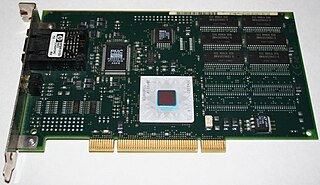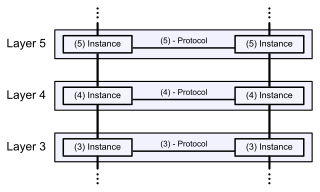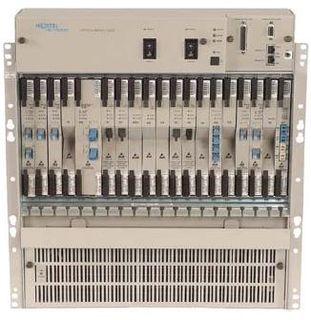
Asynchronous Transfer Mode (ATM) is, according to the ATM Forum, "a telecommunications concept defined by ANSI and ITU standards for carriage of a complete range of user traffic, including voice, data, and video signals". ATM was developed to meet the needs of the Broadband Integrated Services Digital Network, as defined in the late 1980s, and designed to integrate telecommunication networks. Additionally, It was designed for networks that must handle both traditional high-throughput data traffic, and real-time, low-latency content such as voice and video. The reference model for ATM approximately maps to the three lowest layers of the ISO-OSI reference model: network layer, data link layer, and physical layer. ATM is a core protocol used over the SONET/SDH backbone of the public switched telephone network (PSTN) and Integrated Services Digital Network (ISDN), but its use is declining in favour of all IP.

The Open Systems Interconnection model is a conceptual model that characterizes and standardizes the communication functions of a telecommunication or computing system without regard to its underlying internal structure and technology. Its goal is the interoperability of diverse communication systems with standard protocols. The model partitions a communication system into abstraction layers. The original version of the model defined seven layers.
In computer networking, Point-to-Point Protocol (PPP) is a data link layer communications protocol used to establish a direct connection between two nodes. It connects two routers directly without any host or any other networking device in between. It can provide connection authentication, transmission encryption, and compression.

A metropolitan area network (MAN) is a computer network that interconnects users with computer resources in a geographic metropolitan area or region. The term MAN is applied to the interconnection of local area networks (LANs) in a city into a single larger network which may then also offer efficient connection to a wide area network. The term is also used to describe the interconnection of several local area networks in a metropolitan area through the use of point-to-point connections between them.

A virtual private network (VPN) extends a private network across a public network, and enables users to send and receive data across shared or public networks as if their computing devices were directly connected to the private network. Applications running across a VPN may therefore benefit from the functionality, security, and management of the private network. Encryption is a common though not an inherent part of a VPN connection.
A passive optical network (PON) is a telecommunications technology used to provide fiber to the end consumer, both domestic and commercial. A PON's distinguishing feature is that it implements a point-to-multipoint architecture, in which unpowered fiber optic splitters are used to enable a single optical fiber to serve multiple end-points. The end-points are often individual customers, rather than commercial. A PON does not have to provision individual fibers between the hub and customer. Passive optical networks are often referred to as the "last mile" between an ISP and customer.

A broadband remote access server routes traffic to and from broadband remote access devices such as digital subscriber line access multiplexers (DSLAM) on an Internet service provider's (ISP) network. BRAS can also be referred to as a Broadband Network Gateway (BNG).

A metropolitan-area Ethernet, Ethernet MAN, or metro Ethernet network is a metropolitan area network (MAN) that is based on Ethernet standards. It is commonly used to connect subscribers to a larger service network or the Internet. Businesses can also use metropolitan-area Ethernet to connect their own offices to each other.
Advanced Telecommunications Computing Architecture is the largest specification effort in the history of the PCI Industrial Computer Manufacturers Group (PICMG), with more than 100 companies participating. Known as AdvancedTCA, the official specification designation PICMG 3.x was ratified by the PICMG organization in December 2002. AdvancedTCA is targeted primarily to requirements for "carrier grade" communications equipment, but has recently expanded its reach into more ruggedized applications geared toward the military/aerospace industries as well. This series of specifications incorporates the latest trends in high speed interconnect technologies, next-generation processors, and improved Reliability, Availability and Serviceability (RAS).
In telecommunications, a network-to-network interface (NNI) is an interface that specifies signaling and management functions between two networks. An NNI circuit can be used for interconnection of signalling, Internet Protocol (IP) or ATM networks.
Ethernet in the first mile (EFM) refers to using one of the Ethernet family of computer network protocols between a telecommunications company and a customer's premises. From the customer's point of view it is their "first" mile, although from the access network's point of view it is known as the "last mile". A working group of the Institute of Electrical and Electronics Engineers (IEEE) produced the standards known as IEEE 802.3ah-2004, which were later included in the overall standard IEEE 802.3-2008.
Although it is often used for businesses, it can also be known as Ethernet to the Home (ETTH).
One family of standards known as EPON uses a passive optical network.
Operations, administration and management or operations, administration and maintenance are the processes, activities, tools, and standards involved with operating, administering, managing and maintaining any system. This commonly applies to telecommunication, computer networks, and computer hardware.
The MEF, founded in 2001 as the Metro Ethernet Forum is a nonprofit international industry consortium, dedicated to adoption of Carrier Ethernet networks and services. The MEF is no longer referred to as the "Metro Ethernet Forum" because the work of the MEF is now broader in scope, however retains the name "MEF" and "MEF Forum".
Carrier Ethernet is a marketing term for extensions to Ethernet to enable telecommunications network providers to provide Ethernet services to customers and to utilize Ethernet technology in their networks.

The Open Cloud Computing Interface (OCCI) is a set of specifications delivered through the Open Grid Forum, for cloud computing service providers. OCCI has a set of implementations that act as proofs of concept. It builds upon World Wide Web fundamentals by using the Representational State Transfer (REST) approach for interacting with services.
IEEE 802.1ad is an Ethernet networking standard informally known as QinQ and is an amendment to IEEE standard IEEE 802.1Q-1998. The technique is also known as provider bridging, Stacked VLANs, or simply QinQ or Q-in-Q. "Q-in-Q" can for supported devices apply to C-tag stacking on C-tag but this has limited application in the modern methodology of network routing.
ATM Adaptation Layer 2 (AAL2) is an ATM adaptation layer for Asynchronous Transfer Mode (ATM), used primarily in telecommunications; for example, it is used for the Iu interfaces in the Universal Mobile Telecommunications System, and is also used for transporting digital voice. The standard specifications related to AAL2 are ITU standards I.363.2 and I366.1.
ITU-T Y.156sam Ethernet Service Activation Test Methodology is a draft recommendation under study by the ITU-T describing a new testing methodology adapted to the multiservice reality of packet-based networks.
Ethernet virtual circuits (EVCs) define a Layer 2 bridging architecture that supports Ethernet services. An EVC is defined by the Metro-Ethernet Forum (MEF) as an association between two or more user network interfaces that identifies a point-to-point or multipoint-to-multipoint path within the service provider network. An EVC is a conceptual service pipe within the service provider network. A bridge domain is a local broadcast domain that exists separately from VLANs.







